January 26th, 2024
Part One: Central Park as An Outdoor Museum
I have always liked the expression, “A walk down memory lane.” I think of this as stringing together personal memories as a happy sentimental enterprise, which needs little outside visual prompting. For me Central Park has a number of memory lanes that act as visual prompts for recollections, but mostly I am simply looking at seasonal scenes of people animating the park’s landscape in interesting ways. In contrast, I recently realized on one of my regular walks through familiar parts of the park that this was actually a curated walk, so to speak. This is so because Central Park’s first board of commissioners and subsequent official custodians have seen fit to incorporate into this public space sculptures and memorials sited in such ways that they become integral parts of the Central Park experience. Back in 1977, when, under the aegis of the Central Park Task Force, the not-for-profit progenitor of the Central Park Conservancy, which I founded three years later, I wrote and edited with three associates versed in natural history and art history The Central Park Book, which was intended to serve as a guide to the park as a learning laboratory for teachers and others who seek instruction and enrichment from the active processes of nature that undergird the park and are responsible for its 830-acre four-seasons landscape’s appearance. Beyond this are works designed and built by human hands, which are, by intention, an integral part of the park’s landscape in the same way that drawings, prints, paintings, and sculptures are integral to the walls and corridors of a museum as a building in which objects of historical, scientific, artistic, or cultural interest are stored and exhibited.
Thus, the third chapter of the book, which is titled “Changing Tastes in Public Art, begins, “In sharp contrast to the elaborate plans for the geographical layout and planting of Central Park, the inclusion of public sculpture took place in a piecemeal manner. This haphazard approach resulted from the fact that at the inception of the park in 1857, there was only a handful of public monuments in the city, and there was no reason for the park commissioners to anticipate the American desire in the nineteenth century to historicize public spaces as pedagogical showcases with didactic functions of a political, patriotic, and cultural character.”
Continuing here verbatim with certain revisions and additional passages is the following compendiumof collated information on my subject of Central Park’s partial function as an outdoor museum:
The Building of the Central Park Mall
The Park’s designers Frederick Law Olmsted and Calvert Vaux called the Mall “an open-air hall of reception” and arranged American elms in twin allées on either side because their overarching branches would create an impression of architectural space. The northern stretch of the Mall encompasses the Concert Ground, originally featuring a cast-iron bandstand designed by the architect Jacob Wrey Mould, offering a summer program of musical performances. At the same time, the Mall has always remained primarily an arena for strolling and thereby a readymade outdoor gallery for the permanent installation of works of sculpture.
_
By 1873 the placement of memorial sculptures in Central Park was so well established that the commissioners’ committee on statues reported that twenty works had already been offered to the Park. Determined that the essence of the Park should be its landscape, the committee wrote that three things should be supplied in a park: “First, fresh air, purified by abundant foliage. Second, means of tranquilizing and invigorating exercise, as in good quiet roads and streets should be kept free from the irritating embarrassments of the city streets. Third, extended landscapes to refresh and delight the eye, and, therefore, as free as possible from the rigidity and confinement of the city and from the incessant emphasis of artificial objects which inevitably belong to its ordinary conditions.” Even if the essence of the Park was to be its landscape, Thus, although the commissioners realized that, if the essence of the Park was to be its landscape, it was inevitable that statuary would be placed in the Park, and they set forth the following guidelines to control it.”
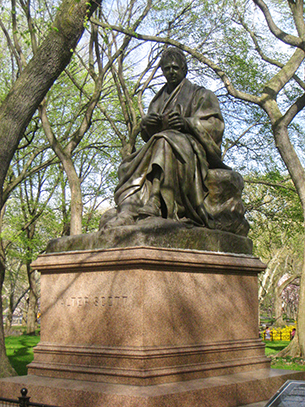
Sir Walter Scott
First – Before any engagement is made to place a statue, or allow a statue to be placed, on the Central Park, it shall be seen in a finished condition, or in a form of a finished model, and a judgment as to its merits, as a work of art, shall have been requested of the respective Presidents of the American Academy of Design, the American Museum of Art, and the American Institutes of Architects.
Second – The determination of a site for any statue shall be reserved until after acceptance.
Third – On each side of the main walk of the Mall, along the line where the statue of [Sir Walter] Scott is now placed, a series of statues may be ranged, commemorative of men or of events of far-reaching and permanent interest. At or near each of the gates of the park, portrait or commemorative statues may also be placed, appropriate to the name of the gate. Portraits or memorial statues shall hereafter be placed nowhere else in the Central Park.
Fourth – Statues or sculptured works designed to represent objects of beauty, of dramatic or poetic interest, may be placed at any points in the park where they shall not dominate a landscape, or, when seen in front, divide the view, over an expanse, lawn or glade.
Fifth – A statue, commemorative of any person, shall not be placed in the Central Park, until after a period of at least five years from the death of the person represented.
_
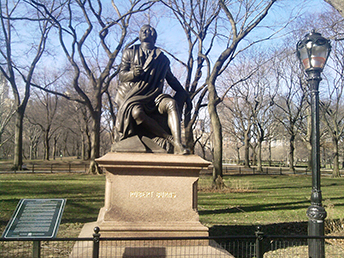
Robert Burns
The second memorial statue to be installed on the Mall was that of Sir Walter Scott’s compatriot Robert Burns (1759–1796), composer of Auld Lang Syne, a panegyric extolling the bond of friendship among kindred souls who are not necessarily Scots but any socially or politically united group who share a strong cultural pride often displayed by attending various kinds of reunions that elicit brotherly and sisterly bonding as well as patriotism. That this song’s words of friendship are sung in a lilting Scottish brogue gives them the combined aura of the simultaneously forever historic past and the unknown eternal future is a good reason for this Gaelic-inflected song to be the ubiquitous “ringing in” accompaniment of New Year’s midnight bells and tooting of horns.
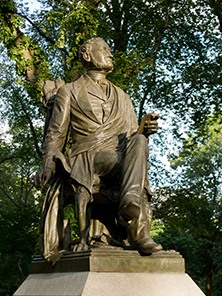
Fitz-Greene Halleck
With the unveiling of the sculpture of Burns in October 1880, the southern end of the Mall became a showcase for other portrait sculptures of men of letters, and it was soon permanently known as Literary Walk with the installation of Fitz-Greene Halleck (1790–1867), a poet and essayist best known at the time for his satirical and romantic verse, a poetic output due to his close literary relationship with his paramour Joseph Rodman Drake, whose death in 1820 prompted a widely read elegy by Halleck and thereby established his reputation as an accomplished poet. Reading the poem at the Library Company of Philadelphia’s History Month’s 2021 program, Prof. Jordan Alexander Stein noted the musicality of its repeated sounds as well as the intimacy in the lines “And I who woke each morrow / To clasp thy hand in mine, / Who shared thy joy and sorrow, / Whose weal and woe were thine.”
Other poems that were published following Halleck’s own death also express love and longing for men. In his speech, Professor Stein noted that New York’s emerging gay male culture in Halleck’s and Drake’s day was not under the degree of scrutiny it would endure later in the century when anti-vice sentiment and legislation generally focused on female prostitution and not on the male prostitution that existed in areas such as the Bowery. Both Halleck and Walt Whitman (1819–1892) reportedly frequented Pfaff’s, a bar in Greenwich Village known for having female impersonators and “bohemians” among its clientele. The cautionary texts about sexual deviance that did appear in contemporary periodicals such as the Whip could easily be read as informational.
As a poet, Halleck was most prolific in the 1840s. After his death in 1867, his verse came to represent Old New York for writers such as Edith Wharton. Such was his lasting reputation that in May 1877, when President Rutherford B. Hayes unveiled the bronze statue of Halleck on the Mall, the crowd of about 10,000 people did so much damage to Central Park that the city passed an ordinance limiting the size of future events. We can imagine that those who attended the dedication of Fitz-Green Halleck’s memorial in 1877 read a give-away sign of gayness in his crossed legs. Similarly, a 1980 article in the New York Times mentions his “teacup fingers,” another dig at male effeminacy.
Popularity has its price. In May 1877, when President Rutherford B. Hayes unveiled the bronze statue of Fitz-Greene Halleck, the crowd of about 10,000 people gathered on the Mall did so much damage to the site that the city passed an ordinance limiting the size of future public gatherings.
Today, events management in Central Park by the Parks Department and the Conservancy assures orderly public behavior and protection for the park’s landscape and structures. An early example of this, which is particularly relevant in this context, is the “Gay Be-In” on the Sheep Meadow at the end of the first Christopher Street Liberation Day when New York City’s first ever Pride March was held on Sunday, June 28, 1970 (the one-year anniversary of the Stonewall uprising), which, much to the organizers’ surprise, attracted thousands of participants. The celebration logically started in Greenwich Village and then became the Liberation Day March, with its route beginning on Washington Place between Sheridan Square and Sixth Avenue, moving north up Sixth Avenue, and ending with a Gay Be-In happening on Central Park’s Sheep Meadow.
It is tempting to believe that the sculpture of Halleck facing the Sheep Meadow just a few feet to the west on the opposite side of the Mall contains a living soul that encouraged the poet to come down from his granite pedestal and join the gay-rights celebrants on the Sheep Meadow.
Art Historical Commentary
At the time Central Park was founded in 1857, neoclassicism dominated American artistic taste Although influenced primarily by antiquity, neoclassical sculptors also drew inspiration from the recent past and from religious and literary sources. To fill the demand for sculpture, artists traveled to Italy where materials, craftsmen, and models were readily available. Portraiture was a stock in trade for sculptors, who carved likenesses inspired by Roman statues and busts. In their ideal works, these sculptors often imposed a modern sentiment upon forms derived from ancient Greece and Rome. Chaste women, angelic children, and heroic men were conceived in broad, smooth planes and were carved in white, pristine Italian marble. Bronze statues, cast usually in Germany, were occasionally executed for exterior display; however, the static poses and smooth, highly polished surfaces of neoclassical sculptures lent themselves more to marble than to bronze.
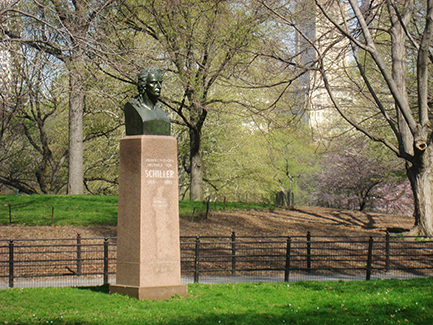
Johann Christoph Friedrich von Schiller
In 1859 the German community in New York once presented the first piece of sculpture that was erected in Central Park, a bronze portrait monument of Johann Christoph Friedrich von Schiller modeled by the German sculptor G. L. Richter to commemorate the life of the noted poet, dramatist, and philosopher. This neoclassic piece, which is characterized by its stylized hair and facial features, its broad, smooth planes, and its truncated, unadorned torso was originally sited in the Ramble beside the Lake on the stair landing of the path that crosses the mouth of the small artificial stream called the Gill. The monument’s monolithic pedestal and the vacant gaze of the lifeless bronze head emanated no sense of Schiller’s devotion to natural science and human rights when I first encountered it in the 1960s as a newly adopted New Yorker taking frequent walks throughout Central Park.
The presence of the Schiller in the Ramble can be explained by the fact that this was the first part of the Greensward Plan to be realized, but the larger story of public sculpture in the Park is centered upon the Mall, which is evocative of a church nave with its vaulted ceiling overarching a wide central aisle flanked by pews (park benches) and occasional alcoves containing sculptures of saints – in this case an elm-tree-canopied promenade between 65th Street Cross drive to the 72nd Street Cross drive, which ends in the sculpturally embellished pair of double staircases flanking the Esplanade of the Bethesda Terrace – that made it the logical site for what the commissioners in their guidelines had stipulated as suitable for a series of commemorative statues of “far reaching and permanent interest.”
With the erection Bryon M. Pickett’s full-length portrait of the inventor Samuel F. B. Morse in 1871 and concluding in 1992 with the transfer of the portrait of Schiller from the Ramble to the Mall where its fragile brownstone pedestal was replaced with a more durable granite base a total of eleven male monuments were arrayed beside the Mall.
_
Although there are a suitable sites throughout the park for individual monuments according to the appearance and size of their proposed landscape settings and proximity to the inner-park circulation arteries that are appropriate for the erection of a monument, which has occurred in the case of Daniel Webster (1876) in the traffic island where the West Drive and the 72nd Street Cross Drive intersect, and the Seventh Regiment soldier, a memorial to the soldiers of New York’s Seventh Regiment who died in the Civil War, located along the West Drive, just north of the Sheep Meadow] the site of choice for sculptures of tribute has remained the Mall. By 2020 a series eleven monuments of men had been installed there beginning in 1871 with the erection of the Sir Walter Scott and Robert Burns and concluding in with the transfer of the portrait of Schiller from the Ramble to the Mall in 1955.
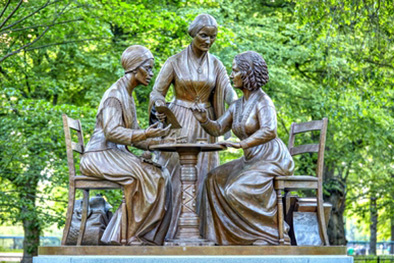
Women’s Rights Pioneers Monument
To several contemporary women’s rights advocates the fact that no life-size portrait sculpture of a woman existed in Central Park became something of a cause célebre until August 26, 2020 when the Women’s Rights Pioneers Monument by Meredith Bergmann depicting famed suffragists Sojourner Truth, Susan B. Anthony, and Elizabeth Cady was installed on the northwest corner of Literary Walk opposite the sculpture of Fitz-Green Halleck on the northeast side.
In addition to the monuments on the Mall and the full-length sculptures of the United States senator and orator Daniel Webster dominating the traffic island where the West Drive and the 72nd cross-drive intersect near the path leading to Strawberry Fields, and and the Seventh Regiment Soldier next to the West Drive north of the Sheep Meadow, there are other sculptures in Central Park, which are simply artistic enterprises in their own right, most of which depict imaginary animals, a special sculptural genre that deserves discussion in my next journal entry.
Share
